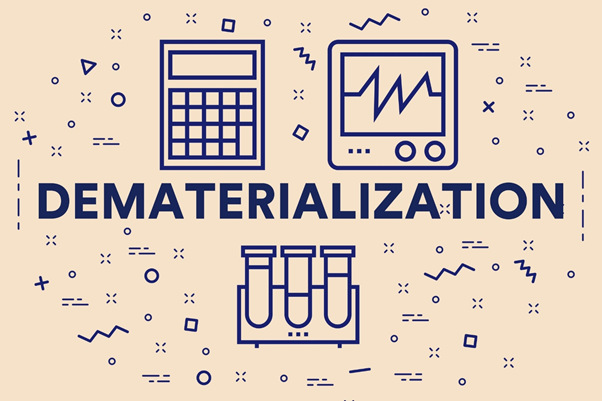What is dematerialization?
Dematerialization or DEMAT refers to the movement from paper certificates (physical form) to an electronic format. Dematerialization aims to ease the process of purchasing, selling, transferring, and holding securities, making it cost-effective and safe. In DEMAT form, all securities are stored in an electronic format instead of a physical certificate.

What was the need for dematerialization?
The concept of dematerialization was introduced to keep track of all paper-based documents. Earlier, shares were issued in paper format, which carried the risk of getting lost or misplaced, potentially leading to financial losses. Dematerialization came into the picture to address such challenges. It also enables accounts to get updated automatically and quickly.
Demat applies to stocks as well as other securities, including mutual funds, bonds, government securities etc.
How can an investor dematerialize the document?
In case an investor has a physical or a paper bond or security and wishes to dematerialize it, he/she can do so by surrendering the document to an intermediary. Once this process is done, the investor would get notified electronically about the security or the bond getting dematerialized, and the investor can then proceed with the transaction.
What are the benefits of dematerialization?
The introduction of dematerialization has eliminated the risk linked to trading or holding shares in physical format. In this section, we would look at some of the advantages of dematerialization.
Convenience
Because of dematerialization, it is easy to carry out transactions electronically. Investors do not need to be physically present at the broker's place to settle the transaction. They can process the transaction using their mobile or laptop.
Fund Transfer
Many online trading platforms provide investors with an option to link their demat account to their bank account. With this, the user can transfer funds electronically. The process eliminates the hassles related to drawing cheques and transferring the funds manually.
Safe
A demat account, which helps the investors process the transaction, is the safest and fastest way to carry out a transaction. All the risk that was associated with the holding physical or paper format gets eliminated.
Option of adding a nominee
The demat account also provides an investor with an option to choose the nominee. In case of the investor's absence, the nominee can operate the account on behalf of the investor.
Tracking of the portfolio
Through dematerialization, an investor can keep track of his/her portfolio on a real-time basis from any location. This enables users to make more profit compared to trading in physical format.
Paperless transaction
Dematerialization supports paperless transactions, which is also beneficial for the environment. The process also reduces the company's cost as transactions are more through the electronic medium than paper format.
Ease in getting corporate benefits
A demat account makes it possible for investors to receive corporate benefits like dividend, refunds, interests etc.
Avail loan facility
Demat account also helps investors to avail loan facility against the holdings in the demat format. These securities then act as collateral.

Source: © Lancelotlachartre| Megapixl.com
How does the demat process start?
The demat process is straightforward. It begins with opening a demat account in which an investor has to fill an account opening form that needs users' basic contact information. The next step is the selection of the depository participants. These depository participants could be various financial institutions and brokerage service firm.
Once the demat account is made, and the depository participant is selected, the next step is to submit the verification document. Verification document requires income proof, identity proof, address proof, bank account proof, and photographs.
Next, the standardized deal is signed with the depository participants. In the next phase, staff from the depository participant would verify the investor's documents in the application.
Once, the documents are verified, the investor's demat account number and ID are generated. These details can be used to access the demat account.
What is a demat account?
A demat account is an account that holds securities in a dematerialized format. The main objective of opening a demat account is to hold shares brought or dematerialized from paper format to electronic format to ease the trading process online.
A demat account holds all forms of securities available for trading, including stocks, bonds, commodities, futures, ETFs, mutual funds, and government securities in one place.
How to use a demat account?
A demat account comes with a trading account that facilitates the trading of various securities. The trading account helps investors to buy, sell and hold stocks. Hence, it is essential to remember that the user should have both demat and the trading account before buying or selling the securities online.
Whenever an investor wants to buy or sell shares, they need to log in to a trading account connected to their bank account. When a buy or sell request is raised, it is sent to the stock's trading account along with other details. The depository participant will then immediately forward the request to the stock exchange. As per the request to buy or sell the stocks, the exchange looks for a seller or buyer of the respective stock selling the specified number of shares. The order then goes to the clearinghouse for the required action concerning the number of shares to be debited or credited.
 Please wait processing your request...
Please wait processing your request...